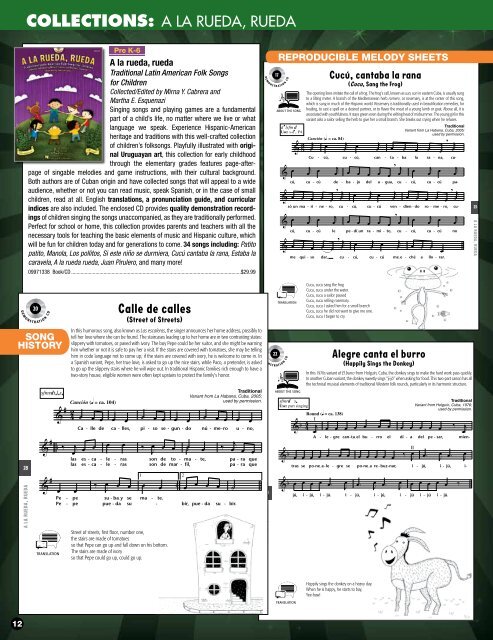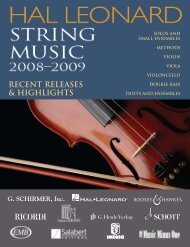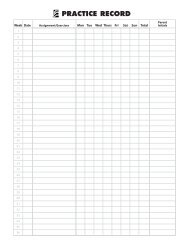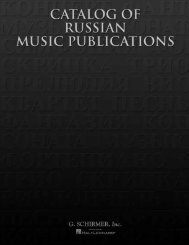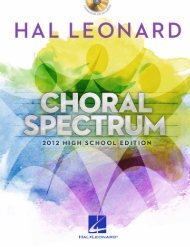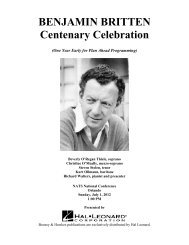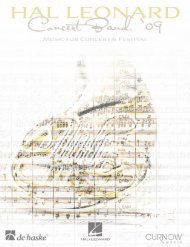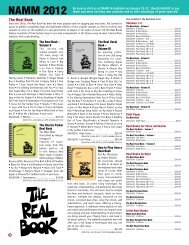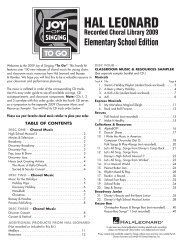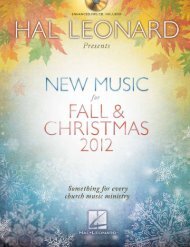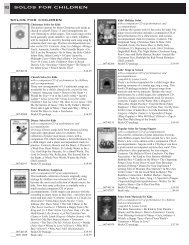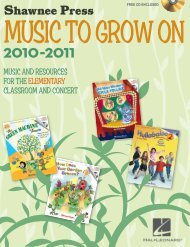musicals - Hal Leonard
musicals - Hal Leonard
musicals - Hal Leonard
You also want an ePaper? Increase the reach of your titles
YUMPU automatically turns print PDFs into web optimized ePapers that Google loves.
Collections: A la rueda, rueda<br />
Pre K-6<br />
A la rueda, rueda<br />
Traditional Latin American Folk Songs<br />
for Children<br />
Collected/Edited by Mirna Y. Cabrera and<br />
Martha E. Esquenazi<br />
Singing songs and playing games are a fundamental<br />
part of a child’s life, no matter where we live or what<br />
language we speak. Experience Hispanic-American<br />
heritage and traditions with this well-crafted collection<br />
of children’s folksongs. Playfully illustrated with original<br />
Uruguayan art, this collection for early childhood<br />
through the elementary grades features page-afterpage<br />
of singable melodies and game instructions, with their cultural background.<br />
Both authors are of Cuban origin and have collected songs that will appeal to a wide<br />
audience, whether or not you can read music, speak Spanish, or in the case of small<br />
children, read at all. English translations, a pronunciation guide, and curricular<br />
indices are also included. The enclosed CD provides quality demonstration recordings<br />
of children singing the songs unaccompanied, as they are traditionally performed.<br />
Perfect for school or home, this collection provides parents and teachers with all the<br />
necessary tools for teaching the basic elements of music and Hispanic culture, which<br />
will be fun for children today and for generations to come. 34 songs including: Patito<br />
patito, Manola, Los pollitos, Si este niño se durmiera, Cucú cantaba la rana, Estaba la<br />
caravela, A la rueda rueda, Juan Pirulero, and many more!<br />
09971338 Book/CD ..............................................................................................................................$29.99<br />
17<br />
reproducible melody sheets<br />
About the Song<br />
d lsfm d<br />
Use: s-d , P4<br />
& 8 6<br />
Cucú, cantaba la rana<br />
(Cucu, Sang the Frog)<br />
The opening lines imitate the call of a frog. The frog’s call, known as sun, sun in eastern Cuba, is usually sung<br />
to a lilting meter. A branch of the Mediterranean herb romero, or rosemary, is at the center of this song,<br />
which is sung in much of the Hispanic world. Rosemary is traditionally used in beautification remedies, for<br />
healing, to cast a spell on a desired partner, or to flavor the meat of a young lamb or goat. Above all, it is<br />
associated with youthfulness. It stays green even during the wilting heat of midsummer. The young girl in this<br />
variant asks a sailor selling the herb to give her a small branch. She breaks out crying when he refuses.<br />
Canción (q = ca. 84)<br />
j œ<br />
Cu<br />
& œ j œ œ j œ<br />
&<br />
œ<br />
j œ œ j œ<br />
œ œ œ œ œ<br />
- cú, cu - cú, can - ta - ba la ra - na, cu-<br />
,<br />
œ œ œ œ œ<br />
cú, cu - cú de - ba - jo del a - gua, cu - cú, cu - cú pa-<br />
,<br />
j<br />
œ œ œ œ œ œ<br />
œ<br />
j œ œ j œ<br />
j<br />
œ<br />
œ<br />
,<br />
j<br />
œ<br />
j œ œ j œ<br />
,<br />
j<br />
œ œ œ œ œ œ<br />
sóIun ma - ri - ne - ro, cu - cú, cu - cú ven - dien - do ro - me - ro, cu-<br />
& œ j œ œ j œ<br />
&<br />
,<br />
j<br />
œ œ œ œ œ œ<br />
cú, cu - cú le pe - díIun ra - mi - to, cu - cú, cu - cú no<br />
,<br />
j<br />
œ œ œ œ œ œ<br />
œ<br />
j œ œ j œ<br />
Traditional<br />
Variant from La Habana, Cuba, 2005;<br />
used by permission.<br />
œ<br />
œ œ œ<br />
j œ œ j œ<br />
me qui - so dar, cu - cú, cu - cú meIe - ché a llo - rar.<br />
œ<br />
25<br />
A L A R u e dA , R u e dA<br />
28<br />
A L A R u e dA , R u e dA<br />
20 Calle de calles<br />
(Street of Streets)<br />
song<br />
history<br />
sfmrdt l s<br />
tRAnSLAtIon<br />
In this humorous song, also known as Las escaleras, the singer announces her home address, possibly to<br />
tell her love where she can be found. The staircases leading up to her home are in two contrasting states:<br />
slippery with tomatoes, or paved with ivory. The boy Pepe could be her suitor, and she might be warning<br />
him whether or not it is safe to pay her a visit. If the stairs are covered with tomatoes, she may be telling<br />
him in code language not to come up; if the stairs are covered with ivory, he is welcome to come in. In<br />
a Spanish variant, Pepe, her true love, is asked to go up the nice stairs, while Paco, a pretender, is asked<br />
to go up the slippery stairs where he will wipe out. In traditional Hispanic families rich enough to have a<br />
two-story house, eligible women were often kept upstairs to protect the family’s honor.<br />
& # (q = ca. 104)<br />
2Canción<br />
4 œ œ œ œ<br />
& # . ‰ j œ œ œ<br />
Ca - lle de ca - lles, pi - so se - gun - do nú - me-ro<br />
u - no,<br />
las es - ca<br />
las es - ca<br />
-<br />
-<br />
œ<br />
le<br />
le<br />
Street of streets, first floor, number one,<br />
the stairs are made of tomatoes<br />
so that Pepe can go up and fall down on his bottom.<br />
The stairs are made of ivory<br />
so that Pepe could go up, could go up.<br />
œ<br />
œ<br />
ras<br />
ras<br />
œ œ œ<br />
‰<br />
œ<br />
œ œ<br />
J<br />
œ<br />
son de<br />
son de<br />
to -<br />
mar -<br />
& # 1<br />
‰ œ<br />
œ œ<br />
J<br />
œ œ œ œ .<br />
Pe<br />
Pe<br />
-<br />
-<br />
pe<br />
pe<br />
-<br />
-<br />
su - baIy se ma - te.<br />
pue - da su<br />
-<br />
œ<br />
œ œ œ<br />
œ˙ œ ‰ j œ œ œ<br />
ma<br />
fil,<br />
Traditional<br />
Variant from La Habana, Cuba, 2005;<br />
used by permission.<br />
œ<br />
- te, pa - ra<br />
pa - ra<br />
2<br />
œ œ œ œ<br />
˙<br />
bir, pue - da su - bir.<br />
œ<br />
que<br />
que<br />
30<br />
A L A R u e dA , R u e dA<br />
tRAnSLAtIon<br />
Cucu, cucu sang the frog<br />
Cucu, cucu under the water.<br />
Cucu, cucu a sailor passed<br />
Cucu, cucu selling rosemary.<br />
Cucu, cucu I asked him for a small branch<br />
Cucu, cucu he did not want to give me one.<br />
Cucu, cucu I began to cry.<br />
The original purchaser of this book has permission to reproduce this song for educational use in one school only. Any other is strictly prohibited.<br />
Copyright © 2010 by HAL LEONARD CORPORATION<br />
International Copyright Secured All Rights Reserved<br />
The original purchaser of this book has permission to reproduce this song for educational use in one school only. Any other use is strictly prohibited.<br />
22 Alegre canta el burro<br />
About the Song<br />
sfmrd s<br />
Use: part singing<br />
Copyright © 2010 by HAL LEONARD CORPOATION<br />
International Copyright Secured All Rights Reserved<br />
(Happily Sings the donkey)<br />
In this 1970s variant of El burro from Holguín, Cuba, the donkey sings to make the hard work pass quickly.<br />
In another Cuban variant, the donkey sweetly sings “ji-jó” when asking for food. This two-part canon has all<br />
the technical musical elements of traditional Western folk rounds, particularly in its harmonic structure.<br />
Round (q = ca. 138)<br />
& b 4 I<br />
j œ œ œ œ œ œ œ œ<br />
A<br />
& b œ œ œ œ œ œ œ<br />
œ œ œ œ œ ‰ j<br />
œ<br />
- le - gre can-taIel bu - rro el dí - a del pe - sar, mien-<br />
œ œ œ œ œ ‰<br />
tras se po-neIa-le - gre se po-neIa re - buz-nar,<br />
i - jú, i - jú, i-<br />
& b œ œ œ œ œ .<br />
J œ<br />
œ . J œ œ .<br />
II<br />
œ<br />
J<br />
œ . J œ œ .<br />
jú, i - jú, i - jú. I - jú, i - jú, i - jú i - jú i - jú.<br />
J œ<br />
Traditional<br />
Variant from Holguín, Cuba, 1976;<br />
used by permission.<br />
œ œ œ œ œ ‰<br />
J œ<br />
tRAnSLAtIon<br />
Happily sings the donkey on a heavy day.<br />
When he is happy, he starts to bay,<br />
Yee-haw!<br />
12<br />
The original purchaser of this book has permission to reproduce this song for educational use in one school only. Any other is strictly prohibited.<br />
Copyright © 2010 by HAL LEONARD CORPORATION<br />
International Copyright Secured All Rights Reserved<br />
The original purchaser of this book has permission to reproduce this song for educational use in one school only. Any other is strictly prohibited.<br />
The original purchaser of this book has permission to Copyright reproduce © this 2010 song by for HAL educational LEONARD use CORPORATION<br />
in one school only. Any other use is strictly prohibited.<br />
International Copyright Secured All Rights Reserved


